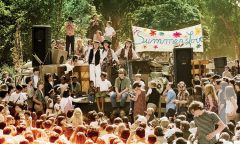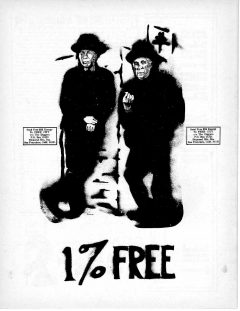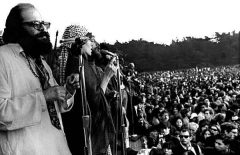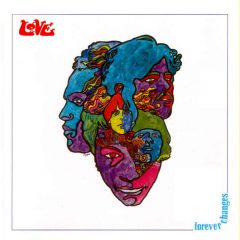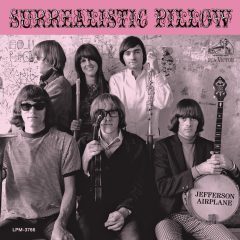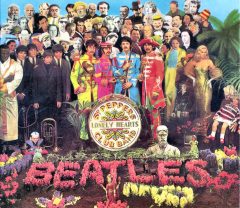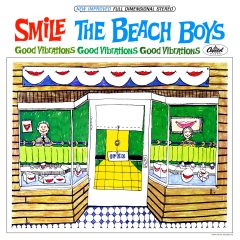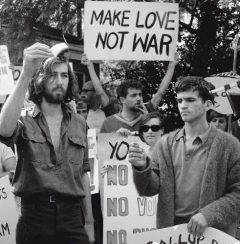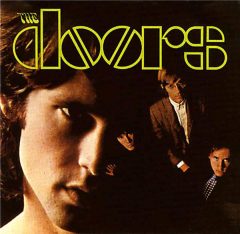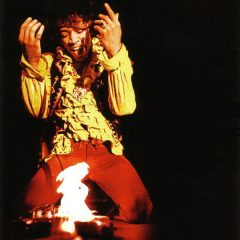Yesterday And Today
Bells, Beads, Flowers & Incensed: The Summer of Love/Summer of Discontent–50 Years On
Dogma = the death of creativity.
– Anonymous
Tribe (as defined by Merriam-Webster): a social group comprising numerous families, clans, or generations together with slaves, dependents, or adopted strangers; a group of persons having a common character, occupation, or interest.
Race (as defined by Merriam-Webster): a contest of speed; a breeding stock of animals; a family, tribe, people, or nation belonging to the same stock; a class or kind of people unified by shared interests, habits, or characteristics.
Racism (as defined by Merriam-Webster): a belief that race is the primary determinant of human traits and capacities, and that racial differences produce an inherent superiority of a particular race; a doctrine or political program based on the assumption of racism and designed to execute its principles–a political or social system founded on racism; racial prejudice or discrimination.
Nostalgia is death. – Bob Dylan (1941—)
Mythological magic–that’s what history is all about. No matter what went down in yesteryear, it is all a narrative by the time it reaches our eyes and ears, and our gray matter decides how to interpret that data, based on the software that we’ve loaded into our cerebral cortex.
Historical inquiry is a conceptual, abstract jigsaw puzzle. And most likely none of the pieces will fit together in a predetermined manner; you have to contour the edges yourself and sort out the cognitive dissonance that occurs when tab A does not fit properly into slot B. That’s what critical thinking skills are all about.
But standing on the shoulders of giants means nada unless we morph into a spiritual and intellectual giant ourselves–to become masters of our own domain, as it were. It is an unnecessary drag to continuously reinvent the wheel as we collectively bulldoze across the landscape of space and time. That is why it is of immense value, from an archetypal perspective, to integrate all we can from the collective consciousness of humanity. Beyond mere diversion or infotainment, that is the true value of why we stockpile stories, myths, fables, and fairy tales. Whether the narrative adds up to your version of personal truth or a viper’s nest of lies and conceits, history offers up an infinite array of perspectives. And if we’re prescient enough to understand how to adapt the lessons of those who have come before us, onto the palette of our current existence, it can serve as an immense shortcut across the junkyard of trash and other disposable aspects of culture, and deliver us upon the alter of wisdom and beauty. However, mature discernment is imperative to navigating history’s multitude of mirrors. We need it to chart a roadmap to the soul and discover how to perceive and behave in this little slice of eternity we call the here and now.
Another thing that history teaches us is this: if you don’t know who you were, you won’t know who you’re going to become. That is why it’s imperative to understand the triumphs and the follies of those who have come before us. And nowhere is that more important than in understanding and digesting the culture and events of the 1960s.
For starters, let’s get one thing perfectly clear: the media distorts everything. Beyond the compassionate notion of “passing it on,” the primary reason to document anything in this existence is because memory is a factual funhouse. Given enough time and enough life experience, our consciousness bends and twists the simplest of experiences and turns them into pretzel logic. Of course, that assumes there was the intention of integrity in what was documented in the first place. It takes courage to stare down your experiences and look them straight in the eye–and even more to share those inner revelations with other beings.
To paraphrase Oscar Wilde, that’s the trouble with being earnest, because unintentional irony can creep into those expressions in the most extreme and subtle ways. And so it is with the cultural brouhaha that we call “the Sixties,” and, in particular, the “Summer of Love.”
â¤â¤â¤â¤â¤â¤
Whether you were fortunate enough to let your freak flag fly and wear your love like heaven in 1967, or you got hip to this mystical Atlantean laboratory second or thirdhand, there’s no denying that the summer of ’67 was a transformational Rorschach, splattered across the brow of the Western mind. Stylistically, it was a period of ruffled collars and garish, radical expressions: body painting and smirking Day-Glo posters, modish pop art clothing, psychedelic musings, Eastern mysticism, starry-eyed optimism, and the breaking of taboos (sexually, intellectually, emotionally). If post-World War II prosperity gave birth to the “teenager,” the future economic and political power base of that adolescent demographic clearly established a different set of social ground rules than from previous generations. There was immediacy–a need for kicks NOW! To play for keeps as it were, due to the outrageous, existential shadow cast by the perpetual threat of atomic annihilation. The Cold War Generation dubbed the Baby Boom (1946—1964) wasn’t interested in theorizing or making concessions: they insisted on living out the ideals and the principles as written in the U.S. Constitution instead of passively becoming cannon fodder in order to fulfill the perversions of an elite faction of political psychopaths.
In fact, a subset of young people all over the world were waking up from the socially engineered mass hallucination of mindless consumerism and senseless wars–to collectively and mindfully create a more intentional, conscious, harmonious existence. By aiming several leagues above their parent’s hypocrisies, they earnestly sought to redress the economic and racial injustices being perpetrated throughout society under the fallacies of “democracy,” “freedom,” “civil rights,” and “liberty and justice for all.” 1967 could more accurately be dubbed the Summer of Discontent, due to the accumulating disgust and indignation over the escalation of the Vietnam War as well as the mandatory conscription of young American men, by bloodthirsty war hawks, to kill and be killed over a conflict in Asia that the United States military had no business becoming entangled with in the first place.
There was a prevailing attitude among young people that there is no such thing as a reasonable or justifiable war. Warmongers are people with a flagrant disregard for all living things. In the Us vs. Them polarization of the era, you are either part of the problem or part of the solution. Either life is sacred, or it isn’t.
The Sixties began with a warning from Dwight D. Eisenhower as he vacated the presidency in January of 1961: “Our military organization today bears little relation to that known by any of my predecessors in peacetime, or indeed by the fighting men of World War II or Korea… we have been compelled to create a permanent armaments industry of vast proportions. We annually spend more than the net income of all United States corporations on military security. In the councils of government, we must guard against the acquisition of unwarranted influence, whether sought or unsought, by the military-industrial complex. The potential for the disastrous rise of misplaced power exists and will persist.” As Stanley Kubrick’s 1964 satirical masterpiece Dr. Strangelove or: How I Learned to Stop Worrying and Love the Bomb demonstrates, the Cold War escalation of nuclear armaments was, and remains, an insane farce. Eisenhower’s successor, John F. Kennedy, understood this grave warning, and fell victim to the “misplaced power” of the Deep State that continues to pursue its odious agenda well into 2017.
â¤â¤â¤â¤â¤â¤
What’s there to live for?
Who needs the Peace Corps?
Think I’ll just drop out.
I’ll go to ’Frisco, buy a wig, and sleep on Owsley’s floor.
– Frank Zappa
Part one of this feature in the May edition of the Troubadour focused on The Explosion of Deferred Dreams by Mat Callahan, a superb historical memoir of the musical and social revolution that went down in San Francisco during the period of 1965—1975. In the appendix of Deferred Dreams, Callahan asserts that 1967 should be more accurately described as the “Vietnam Summer,” and that there was no such thing as a “Summer of Love” or the pejorative “hippie.” He insists that these appellations were a media creation, espoused in the pages of Life, Look, Newsweek, and Time, and repeated so often as to become a common reference point. “The Diggers, the Family Dog, the Oracle newspaper, and the Straight Theater did use the phrase [Summer of Love] in a press release of April 5, 1967, to announce a series of celebratory events and community activities, including sweeping the streets. But love had a lot less to do with this than is commonly believed. The press release and the coinage of the phrase were an attempt to give some direction to what had exploded in January of that year at the Human Be-In [January 14, 1967], when at least 20,000 people had attended a ‘Gathering of the Tribes’ in Golden Gate Park. The local organizations had to deal with the response of the authorities, including repeated instances of police violence. In 1967 alone, the police carried out several massive sweeps down Haight Street, beating and arresting everyone in sight, sending plenty to the hospital, and charging anyone they chose with ‘assaulting a police officer.’ The stakes were raised higher since plans were afoot for a giant festival (the Monterey Pop Festival) that, along with the song ‘San Francisco (Be Sure to Wear Flowers in Your Hair),’ released in May 1967, sought to capitalize on a growing anti-authoritarian sentiment.”
The Monterey International Pop Festival, held over the weekend of June 16—18, and the release of The Beatles’ eighth LP Sgt. Pepper’s Lonely Hearts Club Band on June 1, are universally referred to by historians as the inauguration of the “Summer of Love.” Callahan’s assessment is correct regarding the insipid John Phillips-penned hit for Scott McKenzie: it is a trite, misleading jingle created to promote the Monterey Pop Festival. But despite the ‘Frisco-centric slant of Deferred Dreams, there were arguably even more important musicians and artistic happenings emerging out of Los Angeles and London at that exact same moment. The important thing to remember about the Monterey Pop Festival is the word “International.” Of the 31 musical acts that performed at Monterey, only seven of them were from the Bay Area: Big Brother and the Holding Company, Country Joe and the Fish, Quicksilver Messenger Service, the Steve Miller Band, Moby Grape, Jefferson Airplane, and the Grateful Dead. Of those seven acts, only Janis Joplin with Big Brother could be said to have been a sensation, while Monterey introduced Ravi Shankar to a mainstream rock audience, and catapulted the careers of the Who, Otis Redding, and the Jimi Hendrix Experience.
There was, and still remains, a general animosity between the artistic factions of the Bay Area and the entertainment conglomerate of Los Angeles, viewed by San Francisco longhairs as the “enemy” and the producers of all things “plastic.” “Authenticity” was the buzzword of the day, and anything reeking of teenybopper pre-fabrication, exemplified by the Monkees and AM radio, was dismissed as being beneath contempt. But the reality remains that some of the most enduring and revolutionary music from 1967 was produced in Los Angeles: the Beach Boys’ Smile, the Doors’ self-titled debut and Strange Days, the Buffalo Springfield’s Again, the Byrds’ Younger Than Yesterday, the Mothers of Invention’s Absolutely Free, the Turtles’ Happy Together, and Love’s Forever Changes. Even the Jefferson Airplane’s greatest achievement, Surrealistic Pillow, was recorded in Los Angeles. And Swinging London in ’67 can lay claim to as much, if not more, artistic greatness, producing the likes of the Beatles, the Rolling Stones, the Kinks, the Who, the Jimi Hendrix Experience, Pink Floyd, the Yardbirds, Pretty Things, David Bowie, Cat Stevens, and Procol Harum.
The fact that the Monterey International Pop Festival was primarily orchestrated by two of the slickest movers and shakers of the era, producer/ impresario Lou Adler and musician/ hedonist John Phillips of the Mamas and the Papas, does not diminish one iota the cultural coup they managed to pull off. Harvey and Kenneth Kubernik’s A Perfect Haze is an excellent compendium of souvenirs and recollections of that fabled weekend and deserves a thorough investigation, along with Rhino’s four-CD box set, and the three-disc Criterion Collection edition of the D.A. Pennebaker classic documentary Monterey Pop.
Certainly there is a pretension amongst the arbiters of taste in San Francisco that rivals any other city in American culture. Chief among the elite during the 1960s was San Francisco Chronicle music critic Ralph J. Gleason, who co-founded Rolling Stone magazine with entrepreneur Jann Wenner in 1967. Andrew Loog Oldham, manager and producer for the Rolling Stones, was dispatched, along with Adler, to receive Gleason’s endorsement for Monterey, so that the Bay Area bands would agree to participate with the “evil capitalists” from L.A.: “We drove from the San Francisco airport to Ralph Gleason’s house, sat in his living room, took tea, and spoke in general about life and the festival’s intentions. I did not take to him; he was like a schoolteacher I was lucky enough not to have. He almost gloated as if he were marking our term papers, which of course he was. We were only there an hour or so and then we bid Ralph adieu, tacitly thanked him for his blessing, and got back in the limo to the airport.”
Despite the cultural gulf and ego battles of the chief participants, for the 50th anniversary of Monterey, Lou Adler spoke in San Francisco, stating that the Monterey Pop Foundation, the non-profit charitable organization that grew out of the festival, is still in operation and recently made a $10,000 donation to the Haight-Ashbury Free Clinic.
â¤â¤â¤â¤â¤â¤
I’d love to turn you on…
Depending upon which side of the fence you sit, 1967 was either a watershed year of incredible innovation musically and culturally or it was a vast wasteland of naïve self-indulgence, being the product of a bunch of spoiled, adolescent cretins who were given too many toys to play with. To arrive at your own conclusions, there is a plethora of cinematic documentation left in the era’s wake, including (but certainly not limited to) the aforementioned Monterey Pop, Revolution, Berkeley in the Sixties, Woodstock, the Weather Underground, and Making Sense of the Sixties.
But, again, San Francisco wasn’t the only game in town, and there were happenings going on in Los Angeles, New York, London, and elsewhere internationally, to rival the galas going down in Golden Gate Park. Evidence of the first ever Los Angeles Love-In at Elysian Park on Easter Sunday (March 26, 1967) can be found in Les Blank’s impressionistic short film God Respects Us When We Work, But Loves Us When We Dance. One month later, on April 29, a fund-raising concert for the underground newspaper International Times titled the 14-Hour Technicolor Dream was held at the Great Hall of the Alexandra Palace, London, on 29 April 1967. The event was partially documented in Peter Whitehead’s film Tonite Let’s All Make Love in London.
One of the premier artifacts of the era was produced by CBS-TV News. On April 25, 1967, CBS aired the one-hour special Inside Pop: the Rock Revolution. Hosted by New York Philharmonic music director and composer Leonard Bernstein, Inside Pop bravely attempts to understand the widening chasm that had developed between the pre-World War II “Silent Generation” and the Baby Boom–known as the Generation Gap. “The kids today aren’t going to just accept what’s laid down for them by the older generation,” says one musician. Graham Nash: “Pop singers get through to millions of people. They get through to the kids who are going to become adults.” Frank Zappa: “A lot of the kids who are walking around on the street with long hair that you see from time to time, and wretch over, are going to be running your government for you.”
In the first half of Inside Pop, Bernstein examines the current crop of pop music from the likes of the Beatles, the Left Banke, Bob Dylan, and Janis Ian. It is a master class of music theory and analysis, and deserves repeated viewing. Bernstein: “Many of the lyrics in their oblique allusions and way-out metaphors are beginning to sound like real poems. And protected by this armor of poetry, our young lyricists can say just about anything they care to. The lyrics of Bob Dylan alone would make a bombshell of a book of social criticism. Do you know those ominous lines of his? ‘Something is happening and you don’t know what it is, do you Mr. Jones?’ And you know who Mr. Jones is, don’t you? Us.”
â¤â¤â¤â¤â¤â¤
With our love we could save the world, if they only knew…
Ian MacDonald: “During the last five years of the Sixties, it seemed to many fans of the Beatles that the group was somehow above and beyond the ordinary world: ahead of the game and orchestrating things. So in tune were they with the spirit of their times they sometimes seemed almost godlike, especially to young listeners. In fact, the Beatles, while very observant and in some ways prescient, weren’t so much causing the great social and psychological changes of that era as mirroring them. The key was that they picked up on certain special ideas before most of their immediate competitors, when these ideas were still at an elite stage of development. Moreover, by selling millions of records, the group magnified what it reflected, exporting elite trends and concepts to the intelligent and enquiring side of the mainstream.”
The greatest double-sided single of the 20th century is arguably the psychedelic masterpiece “Strawberry Fields Forever” backed with “Penny Lane.” Released in February of ’67, nowhere else in the Beatles catalog is there a better example of the singular strengths of its individual composers, introducing the world at large with the primary concerns of British psychedelia; a pastoral return to the innocence and awe of youthful wonderment–from the eyes of a child as it were. The psychedelic era wouldn’t have happened if not for the psychotropic influence of marijuana, LSD, psilocybin, mescaline, and peyote. LSD, in particular, inspired a wave of hysteria among its critics, who likened its use to playing Russian roulette with one’s sanity. It is indeed a potentially dangerous drug, as evidenced by some the “acid casualties” of the era: Syd Barrett, Skip Spence, Peter Green, Brian Wilson. But it also contains the potential of spiritual and psychological liberation from the neurotic impulses of an inane culture oriented towards acquisition, acquiescence, and superficial satisfactions.
Bill Hicks on LSD fear-mongering: “How about a positive LSD story? That would be newsworthy, just once, to hear a positive LSD story: ‘Today a young man on acid realized that all matter is merely energy condensed to a slow vibration; that we are all one consciousness experiencing itself subjectively; there is no such thing as death, life is only a dream, and we are the imagination of ourselves. Now here’s Tom with the weather…’”
The more cynical purview of the fascination with childhood purity is to view such musings as the work of a Peter Pan fantasist who refuses to grow up. But the psychedelic worldview could just as easily be interpreted as a symbolic return to the Garden of Eden, an attempt at dissolving the corrupt and impure influences of a materialistic society. Indeed, the post-modern world is awash with Faustian temptations, in order to “gain the world and lose their soul,” to quote George Harrison.
â¤â¤â¤â¤â¤â¤
Love is all you need…
Everyday on the radio we celebrate the songs and sentiments of 1967, and with good reason–not before or since has the Billboard Hot 100 been filled with such an eclectic, dynamic, and inspiring mix of popular music. You didn’t have to be alive in ’67 to appreciate in hindsight what Lester Bangs wrote in 1981 regarding the resurgent popularity of the Doors: “You can deny it all you want but almost none of the groups that have been offered to the public in the past few years begin to compare with the best from the Sixties. And this is not just Sixties nostalgia–it’s a simple matter of listening to them side by side and noting the relative lack of passion, expansiveness, and commitment in even the best of today’s groups. There is a halfheartedness, a tentativeness, and perhaps worst of all a tendency to hide behind irony that is after all perfectly reflective of the time, but doesn’t do much to endear these pretenders to the throne. Sure, given the economic climate alone as well as all the other factors it was a hell of a lot easier to go all-out berserk, yet hold on to whatever principles you had in the Sixties–today’s bands are so eager to get bought up and groomed and sold by the pound it often seems as if even the most popular and colorful barely even exist, let alone stand for anything.” In 2017, with 40 more years of perspective, this damning indictment of contemporary pop culture’s insignificance is more profound and relevant than ever.
John Lennon in 1971: “Apathy isn’t it. We can do something. So flower power didn’t work–so what. We start again.”
In 1987, Granada television in the U.K. produced a remarkable documentary by John Sheppard for the 20th anniversary of Sgt. Pepper’s titled It Was Twenty Years Ago Today as a tie-in with the Beatles’ publicist Derek Taylor’s book of the same name. The interviews are insightful, and much of the b-roll is incredible, allowing the viewer to subtract the spin of the narration and see the footage for what it represents: a reasonably objective record of what went down in 1967: the drug busts of Mick Jagger and Keith Richards; what the San Francisco Diggers in the Haight-Ashbury represented; the attempt by radicals to levitate the Pentagon. As it dutifully ticks off all the proper historical events of the era, it concludes by asking a number of the period’s most notorious figures a summarizing question: “Is love all you need?” The most profound and thoughtful response comes from the poet and Beat Generation bard Allen Ginsberg, no stranger to mystical exploration, drugs, transcendence, and spiritual discipline. His reply is an epigram for the ages: “I would say awareness is all you need. And that love stems from awareness.”
There is a Zen expression: “If you can copy a master, you can become a master.” The music of the Beatles, and many others of the era, offers a master class in becoming conscious. The challenge remains in learning how to apply Ginsberg’s sentiments to every aspect of life, and that is the true value of studying the attitudes, ideas, and events left in the wake of the psychedelic Sixties. Before the optimism of ’67 gave way to the militant and traumatizing violence of 1968 and beyond, there was a season of hope and inclusiveness that shimmered in the hearts and minds of people throughout the planet. 1967 was a time where a significant number of human beings explored the power of love and its ability to transform relationships and heal the world. That effort and vibration continues to reverberate in the music and art of the period, should you possess the ability to read the portents properly. Peace and love are political acts that never go out of style: it is simply a matter of adjusting your value system and becoming mindful of what you are going to project outwardly to every person you meet. Anyone can be hateful and hostile; it takes strength to be gentle and kind. The summer of ’67 is brimming with transformational mentors of how to become cosmically conscious–it’s a matter of being aware and choosing to emulate the masters.
Love. Om. Shanti. And may the smile you send out return to you.
â¤â¤â¤â¤â¤â¤
20 CLASSIC LPs FROM 1967
– The Doors/The Doors
– Between the Buttons/The Rolling Stones
– Younger Than Yesterday/The Byrds
– Surrealistic Pillow/Jefferson Airplane
РWalk Away Ren̩e/Pretty Ballerina/The Left Banke
– I Never Loved a Man the Way I Love You/Aretha – Franklin
– The Velvet Underground & Nico/The Velvet Underground
– Are You Experienced/The Jimi Hendrix Experience
– Absolutely Free/The Mothers of Invention
– Sgt. Pepper’s Lonely Hearts Club Band/The Beatles
– The Piper at the Gates of Dawn/Pink Floyd
– Something Else/The Kinks
– Smiley Smile/The Beach Boys
– Buffalo Springfield Again/Buffalo Springfield
– Disraeli Gears/Cream
– Strange Days/The Doors
– Forever Changes/Love
– Pisces, Aquarius, Capricorn & Jones Ltd./The Monkees
– Days of Future Passed/The Moody Blues
– Axis: Bold as Love/The Jimi Hendrix Experience
– The Who Sell Out/The Who
10 GROUNDBREAKING 45s FROM 1967
– “Let’s Spend the Night Together” b/w “Ruby Tuesday” by the Rolling Stones
– “Strawberry Fields Forever” b/w “Penny Lane” by the Beatles
– “Happy Together” b/w “Like the Seasons” by the Turtles
– “I Can Hear the Grass Grow” b/w “Wave the Flag & Stop the Train” by the Move
– “Pictures of Lily” b/w “Doctor, Doctor” by the Who
– “Light My Fire” b/w “The Crystal Ship” by the Doors
– “See Emily Play” b/w “Scarecrow” by Pink Floyd
– “All You Need Is Love” b/w “Baby You’re a Rich Man” by the Beatles
– “Heroes and Villains” b/w “You’re Welcome” by the Beach Boys
– “Itchycoo Park” b/w “I’m Only Dreaming” by Small Faces





